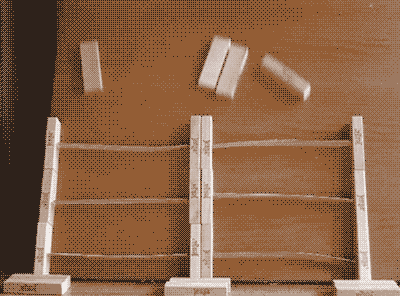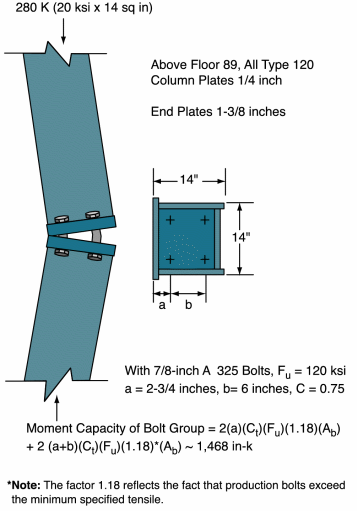OneWhiteEye
Senior Member
At least two serious issues have been brought up in relation to psikeyhackr's small physical model, scaling and inapplicable failure mode. All the same, it should be possible to build a scaled down physical model which will self-crush given a modest initial defect. While I liken the towers to a house of cards as the nearest everyday category of metastable systems, if the work of Bazant, Seffen and others has any validity, the formulations should allow design for such a structure.
Indeed it could be done, but not as easily as the paper loops and washers on a stick (unless you're more clever than I, which is certainly possible).
The basic criterion for progressive collapse in a simple 1D model like this is that energy expended on crushing supports is less than potential energy lost in the act of crushing. Several years ago I showed psikeyhackr how this characteristic plays out in terms of load displacement diagrams [1] and how a 1D stepwise algebraic model could be used to reproduce his paper loops and washer result [2] given the model data. Finally, I did a physical experiment on paper loops of the given spec to show that they do not satisfy the basic criterion for progressive collapse [3]. That pretty much covers the whys and wherefores of why this model arrests.
Once the basic physics is understood and accepted, it suffices to note that, since it did arrest, it doesn't model the properties of steel columns in axial compression despite being "as weak as possible" statically. It can be argued that it does model the action of so-called "stout" columns which fail via diamond/concertina folding, which could lead to arrest, but the nature of this argument is akin to debating how many angels can dance on the point of a pin. This is the tack in Tony Szamboti's most recent paper but, as I showed elsewhere on this forum, he didn't even know that was the case.
Satisfying the static constaint of stably self-supporting without defect and yet also the dynamic constraint on energy dissipation while crushing supports comes naturally when scaled to the level of the towers. These are superlative structures in which great effort and expense go towards making it sufficiently strong, yet not many times stronger than is necessary. At everyday scales, finding something which preserves those characteristics is difficult. The best suggestion I can offer is very thin glass rods as supports. What a pain to assemble.
[1] http://www.rationalskepticism.org/post649597.html#p649597
[2] http://www.rationalskepticism.org/post636274.html#p636274
[3] http://www.rationalskepticism.org/post796166.html#p796166
------------
Side note on thought experiments: I was bored during a commute the other day when I considered the case of an ideal rigid disk rotating at relativistic speed, and was led to the apparent geometric paradox of the relation circumference not equal to pi times diameter. Admittedly, I did have a class in special relativity so maybe I was just remembering something I already heard, but it hardly matters. Figuring I wasn't the first, I looked and, sure enough, it's the Ehrenfest paradox (https://en.wikipedia.org/wiki/Ehrenfest_paradox). Interesting that it took about four years after SR was published before this was formulated.
From the WP article:
Thought experiments are wonderful things.
Indeed it could be done, but not as easily as the paper loops and washers on a stick (unless you're more clever than I, which is certainly possible).
The basic criterion for progressive collapse in a simple 1D model like this is that energy expended on crushing supports is less than potential energy lost in the act of crushing. Several years ago I showed psikeyhackr how this characteristic plays out in terms of load displacement diagrams [1] and how a 1D stepwise algebraic model could be used to reproduce his paper loops and washer result [2] given the model data. Finally, I did a physical experiment on paper loops of the given spec to show that they do not satisfy the basic criterion for progressive collapse [3]. That pretty much covers the whys and wherefores of why this model arrests.
Once the basic physics is understood and accepted, it suffices to note that, since it did arrest, it doesn't model the properties of steel columns in axial compression despite being "as weak as possible" statically. It can be argued that it does model the action of so-called "stout" columns which fail via diamond/concertina folding, which could lead to arrest, but the nature of this argument is akin to debating how many angels can dance on the point of a pin. This is the tack in Tony Szamboti's most recent paper but, as I showed elsewhere on this forum, he didn't even know that was the case.
Satisfying the static constaint of stably self-supporting without defect and yet also the dynamic constraint on energy dissipation while crushing supports comes naturally when scaled to the level of the towers. These are superlative structures in which great effort and expense go towards making it sufficiently strong, yet not many times stronger than is necessary. At everyday scales, finding something which preserves those characteristics is difficult. The best suggestion I can offer is very thin glass rods as supports. What a pain to assemble.
[1] http://www.rationalskepticism.org/post649597.html#p649597
[2] http://www.rationalskepticism.org/post636274.html#p636274
[3] http://www.rationalskepticism.org/post796166.html#p796166
------------
Side note on thought experiments: I was bored during a commute the other day when I considered the case of an ideal rigid disk rotating at relativistic speed, and was led to the apparent geometric paradox of the relation circumference not equal to pi times diameter. Admittedly, I did have a class in special relativity so maybe I was just remembering something I already heard, but it hardly matters. Figuring I wasn't the first, I looked and, sure enough, it's the Ehrenfest paradox (https://en.wikipedia.org/wiki/Ehrenfest_paradox). Interesting that it took about four years after SR was published before this was formulated.
From the WP article:
The paradox has been deepened further by Albert Einstein, who showed that since measuring rods aligned along the periphery and moving with it should appear contracted, more would fit around the circumference, which would thus measure greater than 2πR. This indicates that geometry is non-Euclidean for rotating observers, and was important for Einstein's development of general relativity
Thought experiments are wonderful things.



